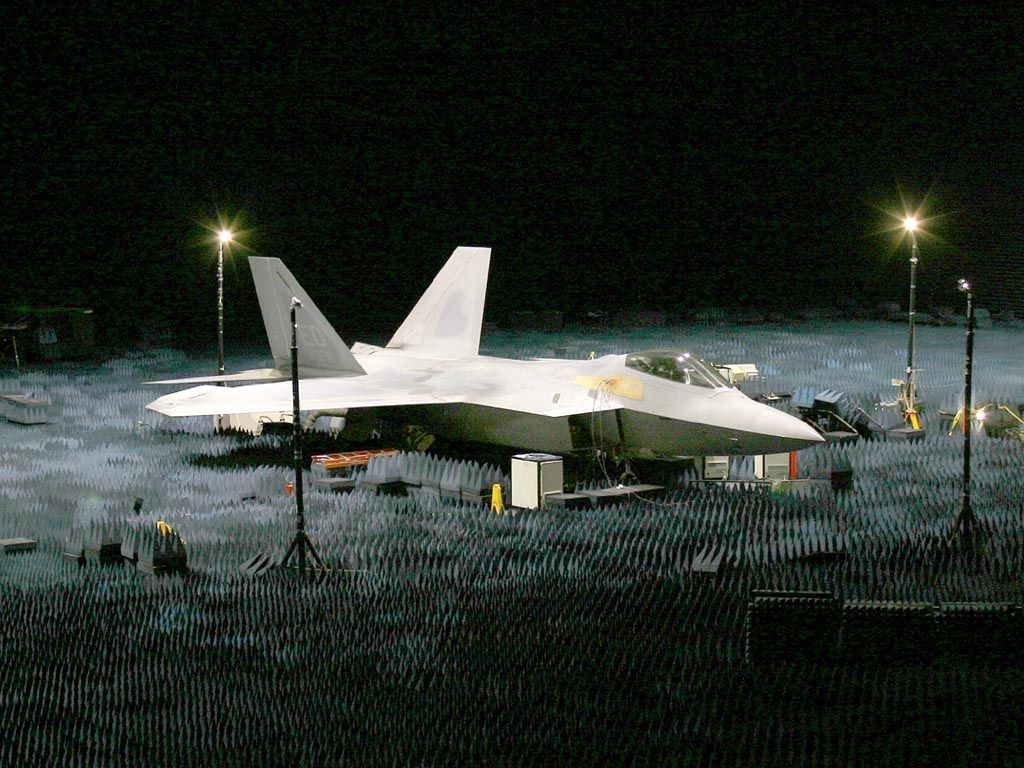Re: Final estimate for J-20 canards' radar return energy is 3.276x10^-19
Your quite general source reads...
Here is a source to prove that...
The only type of absorber that can affect up to five-9s of the impinging signal would be the pyramidal type...
Absorber performance is highly dependent upon the targeted freqs, even if it is 'wideband'.
Here is an F-22 in an EM anechoic chamber...

All those pyramidal absorbers would give us the most accurate RCS measurement of any object since they will absorb any chamber walls reflections that could constructively interfere with the reflections off the aircraft.
If absorber in general would affect five-9s of the impinging radar signal as you (falsely) claimed, there would be no need for shaping at all since whatever left of the signal -- the echo -- would lose even more energy on the way back to the seeking radar. What is that about energy loss to the square of the distance rule? Why not coat the whole aircraft with the stuff instead of just the canards? If this is true, we would have never built the F-117 in the first place looking funky as it is?
Even if you do not have relevant experience in the field, IF you actually read your source carefully, scant as it is, you would not have made the ridiculous claim that an airborne absorber would affect up to five-9s of the impinging signal.Since you're a new member and appear totally clueless, I would appreciate it if you clicked on the link that I provided before giving me an offhand and flippant reply. The Answers.com link is to an article by McGraw-Hill encyclopedia. McGraw-Hill is one of the largest publishers in the United States and they were the owners of Businessweek, until its recent sale to Bloomberg. My citation on RAM effectiveness is McGraw-Hill Science and Technology Encyclopedia, not Answers.com.
Your quite general source reads...
The quarter wavelength rule is quite applicable to airborne absorber. As material DECREASING thickness approaches quarter wavelength of the targeted freq, absorber performances decreases. In most cases, the targeted freq is the X-band, which is the centimetric (cm) band. We found out a long time ago that increasing thickness to greater than quarter wavelength would incur an unacceptable weight penalty, especially if the absorber is of the magnetic type, which are ferrite particles in a dielectric containment, aka sheet or liquid applique.To produce such absorbers, it is necessary in practice to taper the material over distances which are large compared with the wavelength of the frequencies to be absorbed. Therefore, practical absorbers of this type giving greater than 20dB absorption vary in thickness from about 0.8 in. (2 cm) at 10 GHz and above to 6 ft. (2 m) at 100 MHz and above. The absorber performance improves with increasing thickness until the point is reached where all of the energy that enters the material is absorbed and only the front-face reflection is left. While this type of absorber is capable of producing a high degree of absorption over a broad bandwidth, it is at the same time a relatively thick material.
Here is a source to prove that...
Silicone and polyurethane sheets are a thin flexible resonant absorber available for frequencies within 1.5 to 18 GHz. The typical reflectivity is – 25 dB at the centre frequency and the band width is 10%.
The only type of absorber that can affect up to five-9s of the impinging signal would be the pyramidal type...
The performances of pyramidal absorbers are better than flat absorbers particularly at higher frequencies where any reflections from the surface of the pyramids tend to be channelled down into the absorber. When the height of the pyramids is greater than 10 wave lengths the reflectivity may reach –52 dB.
Absorber performance is highly dependent upon the targeted freqs, even if it is 'wideband'.
Here is an F-22 in an EM anechoic chamber...

All those pyramidal absorbers would give us the most accurate RCS measurement of any object since they will absorb any chamber walls reflections that could constructively interfere with the reflections off the aircraft.
If absorber in general would affect five-9s of the impinging radar signal as you (falsely) claimed, there would be no need for shaping at all since whatever left of the signal -- the echo -- would lose even more energy on the way back to the seeking radar. What is that about energy loss to the square of the distance rule? Why not coat the whole aircraft with the stuff instead of just the canards? If this is true, we would have never built the F-117 in the first place looking funky as it is?

